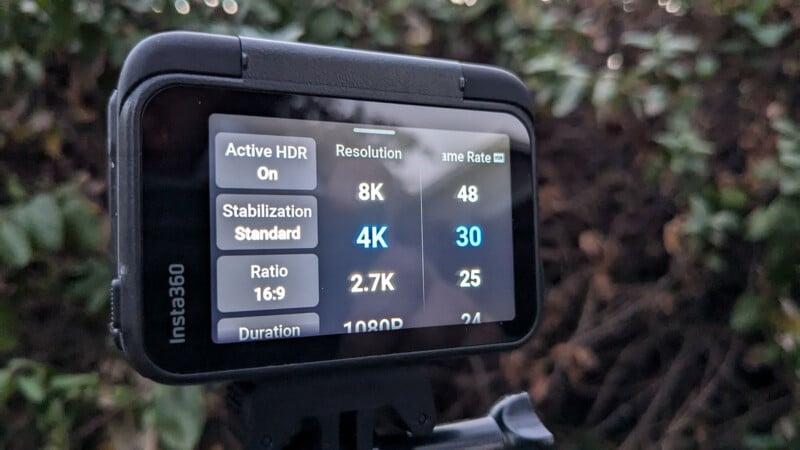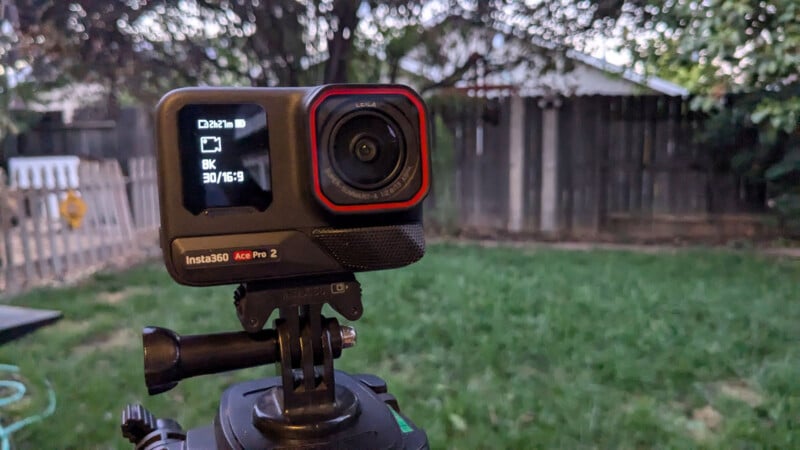Insta360 Ace Pro 2 Review: It Puts Other Action Cameras on Notice

If the original Ace Pro was Insta360’s way of getting its bearings in the traditional action camera landscape, its new Ace Pro 2 is its way of putting the rest of the action world on notice.
Armed with a deep repertoire of additions and upgrades from its predecessor, including everything from a new Type 1/1/3 8K-capable sensor to a pair of high-powered AI image processing chips, the Ace Pro 2 seems poised to compete directly with flagship models from DJI and GoPro — the latter being the industry’s long standing gold standard.
About the Insta360 Ace Pro 2
- Price: $399.99
- Video Resolution: Up to 8K HDR at 30/25/24 fps
- Photo Resolution: Up to 50MP (8192×6144)
- Microphones: 3 microphones
- Connectivity: Bluetooth 5.2, Wi-Fi (2.4 GHz, 5 GHz)
- Weather Resistance: Waterproof up to 39 feet without protective housing
- Operating temperatures: -4ºF to 113ºF (-20ºC to 45ºC)
- Battery life: up to 180 minutes
- Dimensions (W x H x D): 2.8 x 2.1 x1.5 inches
- Weight: 177.2 grams
If you’re curious how the Ace Pro 2 stacks up directly against the GoPro and DJI counterparts, Chris Niccolls has a video breakdown worth watching. I also cover the competition in a dedicated section below.
Insta360 Ace Pro 2: Design
The Ace Pro 2 follows the same boxy, compact design model that GoPro championed and most other action cameras adopted, including this camera’s older sibling, the Ace Pro. With that being said, the Ace Pro 2 did get a new wardrobe for its debut.
First and foremost, the Ace Pro 2 has a larger, 2.5-inch flip touchscreen than its predecessor. Granted, it’s not much larger (The Ace Pro’s screen is 2.4 inches, per Insta360), but any additional surface area can be considered a good thing for the Pro 2’s intuitive, easy-to-use touchscreen. The controls haven’t changed model-to-model (swipe down for general settings, up for mode settings, middle to change modes and access presets, etc.), but it’s still important to recognize a solid screen when you see one.

Other new design features for the Ace Pro 2 include a wind guard for reducing wind noise and boosting audio clarity and a detachable mic cap for underwater exploration, as well as a new, removable lens guard that Insta360 says is high-strength and scratch-resistant. Plus, the Ace Pro 2 arrives with a new, 1800mAh battery that Insta360 claims will charge to 80 percent in just 18 minutes while also being able to reverse charge other devices like your smartphone. I didn’t put a stopwatch to it, but I can confirm that Pro 2 recharged remarkably fast between recording sessions.

Perhaps the biggest design upgrade, though, is what’s inside the camera. Insta360 says the Ace Pro 2 is the first action camera with a dedicated Pro Imaging Chip for noise reductions and image processing and a second AI Chip for additional image processing and smoother performance. The two chips represent a 100 percent improvement in computing power compared to the Ace Pro, and although I didn’t have the older model on hand to test side-by-side, the detail that these chips helped bring out in my action shots was nothing short of impressive. More on that later.
Insta360 Ace Pro 2: Features
Right off the bat, the Ace Pro 2 can now plunge deeper into the body of water of your choice. Insta360 says the camera is waterproof down to 39 feet, a decent upgrade over the Ace Pro’s (and, coincidentally, the GoPro Hero 13’s) rating of 33 feet. That pairs well with the Ace Pro 2’s new Underwater mode, which is supposed to optimize stabilization and correct distortion in settings where light refraction reduces the camera’s field of view, according to Insta360.
It was a bit too chilly in my neck of the woods to try out Underwater mode (and I didn’t have a mount for the Ace Pro 2’s other new mode, Dashcam), but I did get plenty of experience with other modes and shooting presets for the Ace Pro 2. I failed miserably with my first attempt using the Ace Pro 2’s Starlapse mode (user error, the camera tried its best), but had great experiences with the camera’s Vlog and Bike presets, which as you may expect, tailor the Ace Pro 2’s settings to create ideal conditions for each activity, respectively. FreeFrame Video is a useful mode that basically shoots in 9:16 and 16:9 aspect ratios simultaneously to make it easy to adapt video for both longform and short form social media (YouTube vs. TikTok, per se). And PureVideo, which Insta360 says is meant to boost quality in low lighting settings, was particularly helpful for riding home at dusk after a day on the mountain bike trails.

The Ace Pro 2 has other neat perks like Gesture and Voice Control, which do have some utility but may not ultimately be used very often by your everyday action camera owner. You can also overlay stats from apps like Garmin, Apple, COROS and more on your videos, and the camera’s new Timecode feature allows for multi-cam synchronization if you happen to be at the helm of a production that involves multiple Ace Pro 2s.
The feature that proved the most helpful to me was the Ace Pro 2’s AI Highlight Assistant. It’s a setting you have to toggle on to activate, but it allows you to record a lengthy clip, highlight multiple specific segments from that clip in-camera, and let AI generate those clips into a new video that can standalone or replace the original recording altogether. Basically, it’s an editing shortcut that lets you quickly pull out the interesting stuff from your recording. I found myself using it often to speed up the editing process when I wanted to get videos posted online quickly.
Insta360 Ace Pro 2: Performance
All the specs and all of the features are nice but at the end of the day, it’s what the Ace Pro 2 can do in the real world that makes it truly formidable. My main use case for action cameras is mountain biking, so I naturally swung a leg over the bike as much as I could in a limited review period to see how the stats, the hardware, and the technology actually manifest themselves.
When it comes to image and video quality, the Ace Pro 2 is hard to beat. Shooting in 4Kp60 with Active HDR for mountain biking videos, I found myself recording footage packed with impressive detail, even in less-than-stellar conditions for recording like overcast days and color-bleak landscapes. The same can be said for shooting images: with a maximum photo resolution of 50-megapixels, it did very well in ideal conditions, but impressed me most in the absence of lighting for things like sunset shots.

A quick note: Insta360 will market the Ace Pro 2 heavily as an 8K action camera, which is factually correct. The Ace Pro 2 is capable of 8Kp30 video resolution. However, I barely shot in 8K for three reasons: first, it ate my file space; second, I didn’t have displays capable of seeing a huge, monumental difference between 8Kp30 and 4Kp60; and third, Insta360’s native mobile app, while normally very user-friendly and a great companion tool for the brand’s cameras themselves, was unable to edit 8K video. If I couldn’t edit what I shot, I wouldn’t feel great about being able to post it.
Most integral to an action camera, of course, is stabilization. Insta360’s Flowstate Stabilization technology is automatically enabled in the camera from stock, though Insta360 recommends adjusting the stabilization setting to “High” when it is time to get a bit more extreme. That seemed to be the setting that moved the needle, because the Ace Pro 2’s stabilization was outstanding when set to high. When using PureVideo mode, which sets the stabilization to “Standard” by default, I seemingly lost most of that awesome stabilization technology as I rolled over rock beds and down a fairly technical trail. Additionally, Insta360’s Horizon Lock technology was only available to toggle on when I was shooting in FreeFrame mode. It worked well, but it was interesting to see that feature limited to that specific mode.
Elsewhere under the “performance” umbrella, the Ace Pro 2’s battery life seemed to behave as advertised, and it did surprisingly well to not overheat in warm conditions. We recorded an hour-long podcast episode on the camera on my patio during a sunny day, and by the end of it, the Ace Pro 2 was lukewarm, but nowhere near a concerning temperature. It also recorded great audio (for an action camera), partially thanks to Insta360’s new advanced audio algorithms with three audio modes: wind reduction, voice enhancement, and stereo. The camera is also compatible with a plethora of external mics and bluetooth headsets if you’re after truly high-quality audio to pair with your videos.
Insta360 Ace Pro 2 is a Worthy Competitor in a Crowded Space
The Insta360 Ace Pro 2 is everything an action camera in 2024 should be. It’s bursting with enough features and technology to almost completely automate the experience of recording great footage if you’re a beginner and just want to point and shoot. Beneath the surface, though, it has all the hardware needed for a seasoned videographer to get amazing images and footage out of it.
It’s got a couple of quirks to it, as most cameras do. The concept of 8K isn’t as much of a game changer (yet) as some marketing tactics may lead you to believe, and the camera’s stabilization capabilities can take a hit depending on the settings you have in place. But if you’re like me, a weekend warrior with a desire to learn, Insta360’s Ace Pro 2 is the ideal, all-encompassing action camera that will let you grow while handing you the tools to still have a blast along the way.

Are There Alternatives?
It’s no secret that Insta360 wants to meet GoPro head-on with the Ace Pro 2. The brand’s teaser video for the new camera features it crashing into a living room like an AI-powered comet and obliterating an old action camera that’s just out of focus enough to give Insta360 the benefit of the doubt, but also totally looks like a GoPro.
Subliminal messaging aside, the Ace Pro 2’s spec sheet is geared to try and eclipse the GoPro Hero 13 (as well as the DJI Action 5 Pro) in every conceivable way. It takes the cake in video resolution (8K30fps compared to 5.3K60fps and 4K120fps, respectively), photo resolution (50MP vs. 27MP and 40MP), field of view (157 degrees against 156 and 155 degrees), and even waterproofing (39 feet compared to GoPro’s 33, though the DJI Action 5 Pro is rated up to 65 feet). On paper, it’s hard to argue which is the better camera.

Regrettably, I didn’t have a Hero 13 available to test against the Ace Pro 2. I did, however, have the next best thing in the Hero 12. I took both cameras on the same trail, with optimized action settings for each device, and sat them side-by-side to compare the results. While both cameras showcase great footage that reflect just how far action cameras and their technology have come over the years, to me the Ace Pro 2 stands out as a clear winner both for its detail and superior stabilization. That may change when pitted against the Hero 13, but the Pro 2 definitely seems to outshine the Hero 12 in action settings.
For a more direct spec-for-spec comparison of these three cameras against one another, make sure to check out Chris Niccoll’s video located at the top of this review.
Should You Buy It?
Yes. The Insta360 is one of the most stacked action cameras available today.



